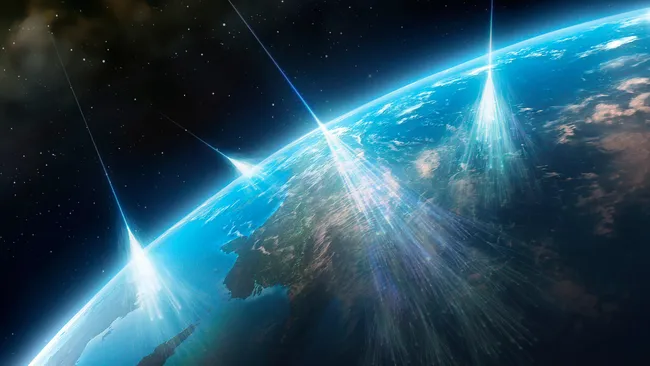Scientists detect the most powerful cosmic rays ever — and their unknown source could be close to Earth
New research reports the most powerful cosmic rays ever detected. Because the rays lose energy as they travel through space, their detection at high energies means they are likely coming from sources relatively close to Earth.
 |
| An artist's illustration of cosmic rays raining down on Earth. (Image credit: Mark Garlick/Science Photo Library via Alamy) |
Scientists have detected the most energetic cosmic rays ever discovered, and they're being produced by mysterious sources relatively close to Earth.
The rays — which consist of electrons and their antimatter counterparts, positrons — were observed at energies all the way up to 40 teraelectronvolts (TeV), or 40,000 times the energy of visible light, livescience.com.
Spotted by the High Energy Stereoscopic System (HESS) observatory in Namibia, the rays lose energy as they travel through space due to their interactions with light and magnetic fields. This means that for rays of this energy to be detected, their sources must be relatively nearby. Yet what, exactly, is producing them remains unknown. The researchers published their findings Nov. 25 in the journal Physical Review Letters.
"This is an important result, as we can conclude that the measured CRe [cosmic ray electrons] most likely originate from very few sources in the vicinity of our own solar system, up to a maximum of a few 1000 light years away, a very small distance compared to the size of our Galaxy," corresponding author Kathrin Egberts, head of experimental astroparticle physics at the University of Potsdam in Germany, said in a statement. (For comparison, the Milky Way is about 100,000 light-years across.)
Cosmic rays are high-energy particles produced by the sun; stellar explosions called supernovas; rapidly spinning neutron stars called pulsars; and other, unknown sources. When the rays smash into Earth's upper atmosphere, they break into showers of particles that are detectable on Earth's surface. But reconstructing the rays that produced these particle showers is a painstaking and uncertain task.
To find the cosmic ray electrons, the researchers used the HESS observatory, an array of five 40-foot (12 meters) telescopes in the Khomas Highland of Namibia.
Over a decade, the telescopes scanned the upper atmosphere for faint signs of Cherenkov radiation left in the wake of the fast-moving rays. Just as a plane traveling faster than the speed of sound creates a sonic boom, a particle moving through a light-slowing medium faster than light creates a faint blue glow around it.
By looking for this glow and using sophisticated algorithms to sift out noise, the scientists created an energy spectrum for the rays hitting Earth in unprecedented detail.
The quantities of these rays decreased drastically at higher energy scales — meaning it will be difficult for smaller space-based detectors to find them in sufficient numbers. Yet the presence of particularly energetic particles gave the scientists a clear indication that at least some of the rays' sources are close to our planet.
"The very low fluxes at larger TeV limit the possibilities of space-based missions to compete with this measurement," corresponding author Mathieu de Naurois, a researcher at the French National Centre for Scientific Research in Paris, said in the statement. "Thereby, our measurement does not only provide data in a crucial and previously unexplored energy range, impacting our understanding of the local neighbourhood, but it is also likely to remain a benchmark for the coming years."






Коментарі
Дописати коментар